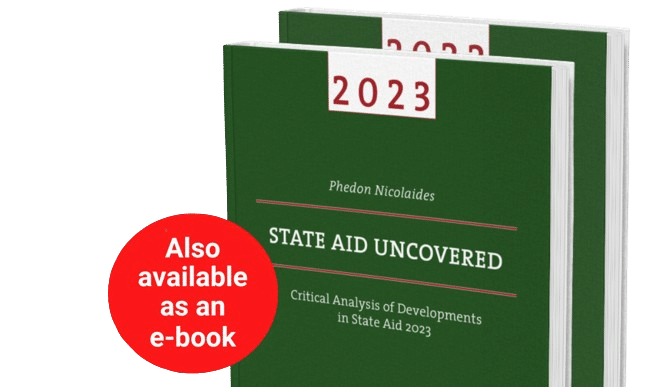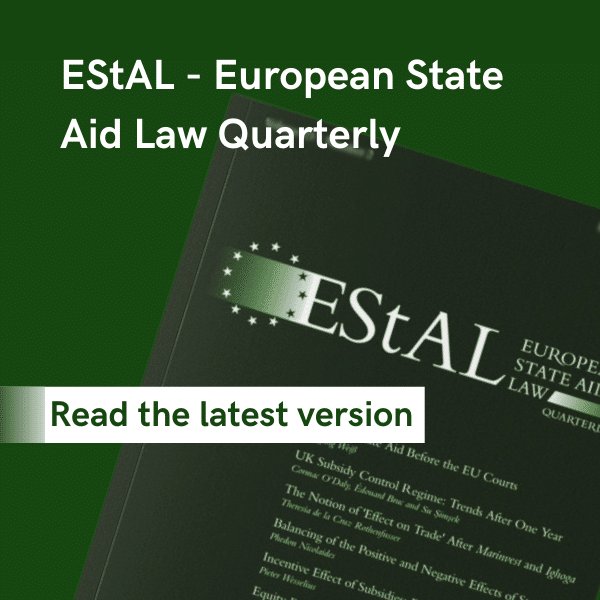
Introduction
- The scope of the GBER has been extensively widened. It now covers almost all categories of exception in Article 107(2) and (3).
- The maximum allowable aid intensity for several types of aid has been raised.
- Many thresholds for notification of individual amounts of aid have also been raised.
The Commission has also done something else which, although it is not formally linked to the revision of the GBER, is likely to have an even more decisive influence on the propensity of Member States to use the GBER instead of the various guidelines. The new guidelines are more rigorous and more demanding. Compliance with their provisions is not a matter of ticking the relevant boxes any more. Formalistic compliance has been replaced with substantive economic analysis of the actual impact of a State aid measure.
The new GBER and guidelines for the period 2014-20 are intended not to overlap, or at least they overlap now much less than in the period 2007-13. This means that Member States do not have the option of using either the GBER or guidelines for the same action any longer. If a measure falls within the GBER, the Commission will refuse to assess a notification by a Member State.
The new guidelines are more uniform than those they have replaced. They all apply explicitly the common assessment principles to their particular subject matter. The common assessment principles elaborate more rigorously the methodology of the “balancing test”, which was first introduced by the State aid Action Plan in 2005.
The common assessment principles, like the balancing test they replace, require market analysis and proof that State aid is an appropriate, necessary and proportional intervention that can address a policy problem without causing an undue distortion of competition. The task of carrying out a credible market analysis and designing a measure that can satisfy those principles is considerably more cumbersome. Member States will naturally be less reluctant to notify a measure if it will be more costly in terms of administrative resources to have it approved and if a fairly similar measure could be adopted on the basis of the GBER at much less cost.
Therefore, the new State aid regime for 2014-20 is likely to lead to a greater use of the GBER because, on the one hand, the GBER covers more types of aid and, on the other hand, the new guidelines are more difficult to comply with. The GBER has become more attractive, while the alternative option of the guidelines is more costly.
Definitions
An immediately obvious difference between the old and the new GBER is the significantly longer section on definitions [143 in the new regulation against 30 in the old regulation]. This depends on the fact that the new GBER includes many more categories and types of aid. In addition, the new GBER also groups together at the beginning various definitions which, in the old GBER, used to be in the various articles on specific conditions for different categories of aid.
Scope
The GBER covers the following categories and types of aid measures:
- Regional aid
- Aid for SMEs
- SME access to finance
- Aid for environmental protection
- Aid for research & development and innovation
- Training aid
- Aid for disadvantaged workers and for workers with disabilities
- Aid to remedy damage caused by certain natural disasters
- Social aid for transport for residents of remote regions [remote regions are the outermost regions plus Cyprus and Malta]
- Aid for broadband infrastructure
- Aid for culture and heritage conservation
- Aid for sport and multifunctional recreational infrastructure
- Aid for local infrastructures
Do you know we also publish a journal on State aid?

The European State Aid Law Quarterly is available online and in print, and our subscribers benefit from a reduced price for our events.
Exclusions and non-application
The GBER does not apply to the following sectors and measures:
- Schemes with budgets that exceed € 150 million
- Export-related activities
- Aid contingent upon the use of domestic products
- Primary agriculture production & fisheries
- Closure of coal mines
- Undertakings with outstanding recovery order [they need to pay back incompatible aid, except in the case of natural disasters]
- Undertakings in difficulty [they may not receive aid, except in the case of natural disasters]
- Non-severable violation of EU law [e.g. required use of domestic products]
When an undertaking is active in sectors which are eligible for aid under the GBER and also in excluded sectors, they ought to have separate accounts.
Individual notification thresholds
Measures adopted on the basis of the GBER do not have to be notified. However, when the amount for an individual award or when the cost of a project exceeds the following thresholds individual notification is necessary:
- Regional investment: € 100 million
- Regional urban development: € 20 million/project
- SME investment: € 7.5 million/undertaking/project
- SME consultancy: € 2 million /undertaking/project
- SME participation in fairs: € 2 million /undertaking/project
- SMEs in ETC: € 2 million /undertaking/project
- Risk finance: € 15 million /undertaking (total)
- Start-ups: € 1-3 million /undertaking
- Fundamental research: € 40 million/under/project
- Industrial research: € 20 million /under/project
- Experimental development: € 15 million /under/project
- Feasibility studies for research activities: € 7.5 million /study
- Investment in research infrastructure: € 20 million
- Innovation clusters: € 7.5 million /cluster
- Innovation aid for SMEs: € 5 million /undertaking/project
- Process & organisational innovation: € 7.5 million /undertaking/project
- Training: € EUR 2 million/project
- Disadvantaged workers: € EUR 5 million/under/year
- Workers with disabilities: € 10 million/under/year
- Environmental investment: € EUR 15 million /undertaking/project
- Energy efficiency: € 10 million
- Operating aid for green electricity: € 15 million /undertaking/project
- Remediation of contaminated sites and district heating and cooling: € 20 million/undertaking/project
- Energy infrastructure: € 50 million /undertaking/project
- Broadband infrastructure: € 70 million /project
- Culture & heritage conservation: € 100 million /project
- Operating aid for culture & heritage conservation: € 50 million /under/year
- Audio-visual works: € EUR 50 million /year
- Sport & multifunctional infrastructure: € 15 million
- Operating aid for sport infrastructure: € 2 million /infrastructure/year
- Local infrastructure: € 10 million /project
Main common provisions
Aid must be transparent
The gross grant equivalent amount of the aid should be calculated without any risk assessment. This is a bit of an exaggeration when it comes to loans and guarantees which necessarily involve some kind of risk assessment. Transparent aid is the following:
- Grants & interest rate subsidies
- Loans using the relevant reference rate
- Guarantees using safe-harbour premiums or approved methodology
- Capped tax advantages
- Regional urban development
- Risk finance & aid for start-ups
- Energy efficiency
- Repayable advances
Aid must have an incentive effect
Aid may not be granted after a project starts and for large enterprises it must be shown that the aid induces them to change their behaviour by, for example, investment more.
Beneficiaries must submit written application before the start of work. The application must contain the following:
- The undertaking’s name and size
- A description of the project & start and end dates
- The location of project
- A list of project costs
- The type of aid and amount of public funding
For ad-hoc to large enterprises, in addition to above, proof must be submitted that that i) in case of regional aid, the project would be in another region or unprofitable or that ii) with aid the project is bigger, wider, etc.
For the following measures, it is presumed that an incentive effect is always present:
- Tax advantages based on objective criteria and which are adopted before projects start
- Regional operating aid
- Access to finance for SMEs
- Aid for disadvantaged and disabled workers
- Reductions in environmental taxes
- Remedy for damage caused by certain natural disasters
- Transport for residents of remote regions
- Culture and heritage conservation
Aid intensity & eligible costs
All figures and amounts must be calculated before tax. Eligible costs must be supported with documentary evidence. Aid that is granted in instalments must be discounted to the granting date using the relevant reference rate.
Cumulation
The GBER very helpfully clarifies that EU funding which is centrally managed and does not come under the control of Member States is not considered State aid. If such EU funding is combined with State aid, only the latter is considered for the purpose of complying with notification thresholds and for respecting maximum aid intensities or amounts.
Aid with identifiable eligible costs may be cumulated with other State aid if eligible costs are different. It may also be cumulated with other State aid for the same eligible costs if the sum remains below the allowed maximum rate of intensity.
Aid without identifiable eligible costs [e.g. risk finance] may be cumulated with other aid with identifiable eligible costs. It may also be cumulated with other aid without identifiable eligible costs if the sum does not exceed the highest financing threshold.
State aid may not be cumulated with de minimis aid for the same eligible costs if the maximum allowed aid intensity is exceeded.
Publication
Member States must publish on a comprehensive State aid website the following:
- A summary information sheet
- The full text of each State aid measure
- Each individual aid award that exceeds € 500,000
Member States have two years to comply with the requirements concerning the publication on a website and the publication of individual awards.
Monitoring
The Commission may withdraw the benefits of the GBER if a Member State does not comply with any of common or specific conditions. Then the Commission may withdraw the benefits with respect to allowable type of aid, aid recipient or granting authority.
Reporting
Member States have to submit to the Commission a summary information sheet within 20 working days of adopting a measure. They must also submit annual reports.
Member States have to maintain detailed records for 10 years and, if requested by the Commission, they must provide it with the relevant information within 20 working days.
Conclusions
The new GBER is undoubtedly the cornerstone of the State aid regime for the period 2014-2020. It covers almost all categories of State aid. Member States will use it extensively.
However, two reservations must be expressed. First, it remains to be seen how useful the new GBER will be to Member States which will not be able to obtain the same degree of legal certainty by notifying State aid.
Second, one cannot exclude the possibility that Member States may be tempted to abuse the wider scope of the GBER by hiding under it aid that otherwise would be incompatible with the internal market. The Commission believes that the requirement for publication of schemes and awards of aid will enable competitors to alert it in case aid is incorrectly granted. We will have to wait to see whether the Commission has placed too much confidence on the ability of competitors to discover instances of incorrect application of the GBER.
[1] The text of the new GBER can be accessed at:
http://eur-lex.europa.eu/legal-content/EN/TXT/?uri=uriserv:OJ.L_.2014.187.01.0001.01.ENG



